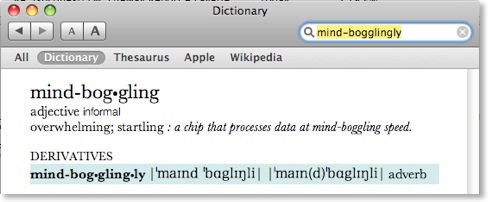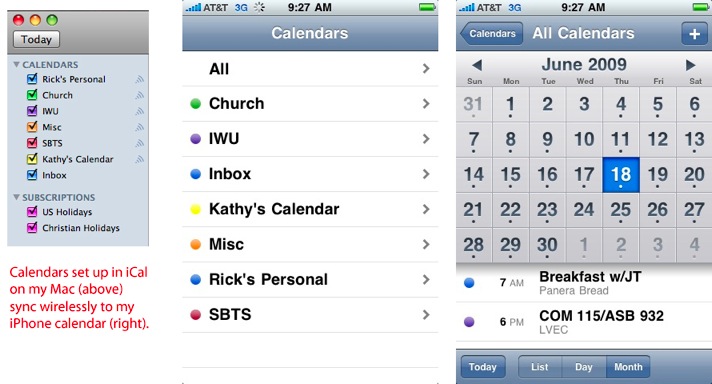The End of the Mac As We Know It (Reflections Upon Snow Leopard)
 Tuesday, September 8, 2009 at 5:38PM
Tuesday, September 8, 2009 at 5:38PM  You realize, of course, that with the advent of Snow Leopard (Mac OS X 10.6), the Mac is dead.
You realize, of course, that with the advent of Snow Leopard (Mac OS X 10.6), the Mac is dead.Bear with me.
I left Windows for good in 1998. I was promised by other Mac users that I was entering a computing nirvana. I was told that Macs never crashed and life would be so much more productive once I made the switch. Well, there was mixed truth in that. I do believe I was more productive--not because Macs never crashed, though. Rather they simply crashed less than Windows machines did.
But Macs had problems of their own. Memory management on the Mac was a mess, in my opinion, in 1998. The Mac OS at that time still used cooperative multitasking, something that Windows had already graduated from by then. And programs on the old Mac OS had set limits from RAM. So, if a program regularly crashed or ran out of memory, you could go into the properties for that program and set the memory to a higher limit. The problem, however, was that once that higher limit was set, the program would use that much memory even when it didn't need it. I heard longtime Mac users talk about this ability to control a program's upper limit of memory as a feature of the Mac OS. You couldn't do that in Windows, after all! But really, in Windows, you didn't need to. I wondered why the Mac OS wasn't smart enough to adjust its own memory.
Nevertheless, I stuck with the Mac, and I've never looked back. I don't stay simply because I'm heavily invested in Mac software (and hardware) at this point. I was heavily invested in Windows software (and hardware) in 1998. I really do believe I'm more productive on a Mac. In fact, I have this little daydream that if I could go back in time, knowing what I know now, and do things over with, I'd have simply used Macs from the beginning. At what point could this have become a reality?
During my freshman year in college, I had a professor warn us during orientation not to use computers for our papers. He said that he and a number of other instructors simply would not accept computer typed papers because they were too hard to read. Those nine-pin dot matrix printers really were too light, you know. So in spite of the fact that I'd been using a computer (a TRS-80 Color Computer) at home since I was 14, and in spite of the fact that I had taken the first computer class my high school ever offered, when I had completed my first quarter in college, I asked my folks to get me a typewriter for Christmas. Sounds pretty lame now.
But hey, it was a great typewriter. A Smith-Corona with spellcheck. Whenever I misspelled a word, the computer beeped alerting me to my error. Then I was able to back up, slip a piece of white correction film between the keys and the paper, retype the misspelled word and then type the correct one. How convenient! Not really.
So, what if for Christmas, 1986, instead of asking for a typewriter, I had simply asked for a Mac Plus? Our campus bookstore carried them at the time. And back then Apple gave significant student discounts. That would have definitely been a game changer.
Or what about 1991? I was about to go off to seminary, and my stepfather informed me that a friend of his said every seminary student needed a good computer. He asked me what kind of computer I wanted. I settled on a 20 MHz CompuAdd 386sx running DOS and Windows 3.0. We bought a copy ofWordPerfect 5.1 for DOS so that I'd be ready for school.
But what if I'd asked for a Macintosh II or a Macintosh LC? Again, it would have been a game changer. To this day, I still have files nearly two decades old that I have to go through all kinds of hoops if I need to open them. Most of them, I don't really need to open, but I'd like to be able just in case. Or occasionally, I become determined to try to update them, but really, who has the time?
Yet, as I entertain my little daydream now and then, I realized one day that there's very little continuity between the Macs of the eighties and nineties and the computers called Macs today. You see, none of use running current computers called MacBooks, MacBook Pros, iMacs and Mac Pros are really using Macs in the original sense of the word. Actually, we using NeXT machines with the label "Mac" on them.
Consider the following quick timeline:
1984: Apple releases the first Macintosh computer using the Motorola 68000 microprocessor.
1985: John Sculley removes Steve Jobs from the Macintosh division which prompts Jobs to leave Apple and form NeXT, Inc.
1989: NeXT releases its first workstation using the NeXTSTEP operating system and a Motorola 68030 processor.
1993: NeXT gets out of the hardware business and NeXTSTEP is ported to Intel's 486 processor as well as RISC and SPARC platforms.
1994: Apple transitions to the RISC PowerPC architecture.
1996: Apple buys NeXT and with it the NeXT OS, now called OpenSTEP.
1997: Steve Jobs regains control of Apple.
2000: OpenSTEP, now renamed "Mac OS X" is released to Mac users as a public beta.
2001: Mac OS X 1.0 is released. Older "Classic" Mac applications can be converted to run on OS X's Carbon layer.
2002: Apple official declares end of development for Mac OS 9 ("Classic").
2006: Apple discontinues use of PowerPC architecture in favor of Intel processors.
2007: Apple releases Mac OS X 10.5 ("Leopard") which does not allow any older Mac software to run in "Classic" mode, even on computers on which it previously ran.
2009: Apple releases Mac OS X 10.6 ("Snow Leopard"), the first version of OS X which will only run on Intel architecture, thus ending any upgrade path for PowerPC architecture.
What this means, my friends, is that none of us using current "Mac" (quotation marks on purpose) computers and software are actually using Macs at all. Actually, we're running NeXTSTEP machines that have simply been labeled as Macs. The transition didn't come all at once. It started with the move from OS 9 to OS X. Then we saw a transition away from PowerPC processors (which Apple claimed for years were superior to Intel processors). And now we see NeXTSTEP, I mean OS X, running only on Intel processors.
So, let's go back to my little daydream. If I had it to do over, what is actually the actual straight path to current Macs? Is it the actual Macintosh line beginning in 1984 or is it actually the NeXT platform launched in 1989? From the perspective of the current OS and perhaps even the processor architecture, and if one considers the evolution of NeXT itself, it's the latter.
This isn't a recent revelation for me. Rather, I first pondered it while watching the documentary Macheads. As I watched people obsess over "Mac culture" and old Mac computers, I thought to myself, that entire platform exists no longer. We're all running NeXT machines.
However, I don't really wish I'd bought a NeXT machine back in the late eighties or early nineties (not that I could have afforded it!). If you look at something as basic as a word processing application, I don't know of any word processors written for NeXT that are still around. There was a version of WordPerfect available for NeXT, but WordPerfect doesn't even exist on the Mac anymore as it once did. No, in my daydream, If I had it to do over with, I'd still get a Mac instead of the Windows machine that I actually began with. Ultimately because Apple (under Jobs' guidance) transitioned Mac users so efficiently from the classic Mac platform to what was once called NeXT OpenSTEP and now OS X, most of us were never even overly aware it was happening.
Ultimately, I don't care if it's a Mac or a NeXT machine that's being called a Mac. I'd rather be here than stuck in Windows (no offense to those of you still there).
And there's some irony here as well. In the end Jobs got the ultimate revenge. He got ousted from his company, so he started a new one. His old company buys the new one and then his new one takes over, ridding itself of all vestiges of the original buyer. And with the release of Snow Leopard, all of what was once the original Mac is now gone--Classic OS, PowerPC architecture and the rest.
Thus, it's the end of the Mac as we know it.
...and I feel fine.
 Apple,
Apple,  Mac OS X,
Mac OS X,  Snow Leopard,
Snow Leopard,  Technology
Technology 







